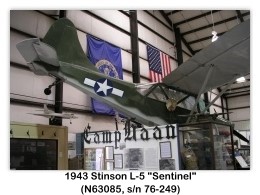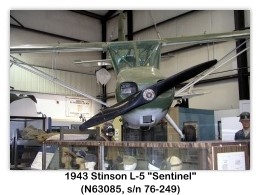
| ||||
|---|---|---|---|---|
 |
 |
 |
 |
 |



























| ||||
|---|---|---|---|---|
 |
 |
 |
 |
 |


























Stinson L-5 Sentinel
Single-engine High-wing Monoplane
Archive Photos 1
1943 Stinson L-5 Sentinel (N63085, s/n 76-249), on display (c.1990) at the March AFB Museum, March AFB, Riverside, California (Photos by John Shupek)

1943 Stinson L-5 Sentinel (N63085, s/n 76-249), on display (9/15/2004) at the March Field Air Museum, Riverside, California (Photos by John Shupek)


Overview 2
The Stinson L-5 Sentinel began life as the pre-war Stinson model 105. The model 105 was nicknamed Voyager and was built by the Stinson Division of Consolidated Vultee. When World War II broke out, the Voyager was redesigned and then entered into service as a liaison aircraft. It also flew in the artillery spotter role and as an air ambulance. The later model Stinson L-5 Sentinels had their fuselages modified to accommodate one stretcher patient. The Stinson L-5 Sentinels were manufactured between October 1942 and September 1945. During this time a total of over 3,896 of these unarmed, two-seat aircraft were built for the United States armed forces, making it the second most widely used light observation aircraft of the war. Personnel in all service branches commonly referred to it as the Flying Jeep.
The Stinson L-5 Sentinel was primarily constructed from steel tubing and plywood and was covered with doped cotton fabric. Capable of operating from forward unimproved airstrips, the Stinson L-5 Sentinel delivered information and needed supplies to the front line troops. On the return trip, it would evacuate the badly wounded soldiers to rear area field hospitals for medical attention.
Variants 2
Five versions were produced for the U.S. Army Air Force (USAAF); the L-5, L-5B, L-5C, L-5E and L-5G. There was no L-5A variant as is often reported, as the designation was intended for conversions of some L-5s modified with 24V electrical systems. The conversions were canceled when the modification became standard on all subsequent models. The Stinson L-5 Sentinel carried a pilot and observer in a tandem seating configuration. The Stinson L-5B through L-5G Sentinels models were modified to carry a litter patient or light cargo, or a rear seat passenger sitting in the normal position. The Navy and Marine versions of the airplane were the Stinson OY-1 and OY-2. The latter differed from all others in that it had a 24 volt electrical system instead of the previously standard 12 volts. The British procured 40 Stinson L-5s, known as Sentinel I’s, and 60 Stinson L-5B’s known as Sentinel II’s.
Aircraft Markings 2
Standard camouflage as delivered from the factory was non-specular medium gray undersides with olive drab above, broken around the edges of the wing and tail surfaces with medium green. Stars, or stars and bars were applied to both sides of the fuselage and on the upper left and lower right wingtips. The USAAF number appeared on both sides of the fuselage in either yellow or black. Most aircraft were repainted silver during the post-WWII period. A variety of unit identification markings including nose art were applied in the field. Interior surfaces were generally finished in chromate green or a slightly darker interior green.
Units Using this Aircraft 2
The USAAF, US Marines, and US Navy used this aircraft in the European, Pacific, and Far East theaters during World War II, and in Korea during the Korean War. The British RAF operated 100 Sentinels in India and Burma. After WWII, the Philippine Army Air Corps used this aircraft from 1945 to 1947. This aircraft remained in service after 1 July 1947 when the PAAC was renamed the Philippine Air Force. The Italian Air Force operated approximately 100 L-5’s from 1946 into the 1950’s. Many other countries also received L-5’s after the war, particularly India.
Postwar Use and Current Status 2
After World War II, the L-5 was widely used by the Civil Air Patrol for search and rescue work. Today there are about 300 known examples left world wide and less than half are in flying condition. A group called the Sentinel Owners and Pilots Association is dedicated to the preservation and enjoyment of this aircraft type.
Operators 2
Specification and Performance Data (L-5) 3
Type
Wings
Fuselage
Tail Unit
Landing Gear
Power Plant
Accommodation
Dimensions
Weights
Performance
References